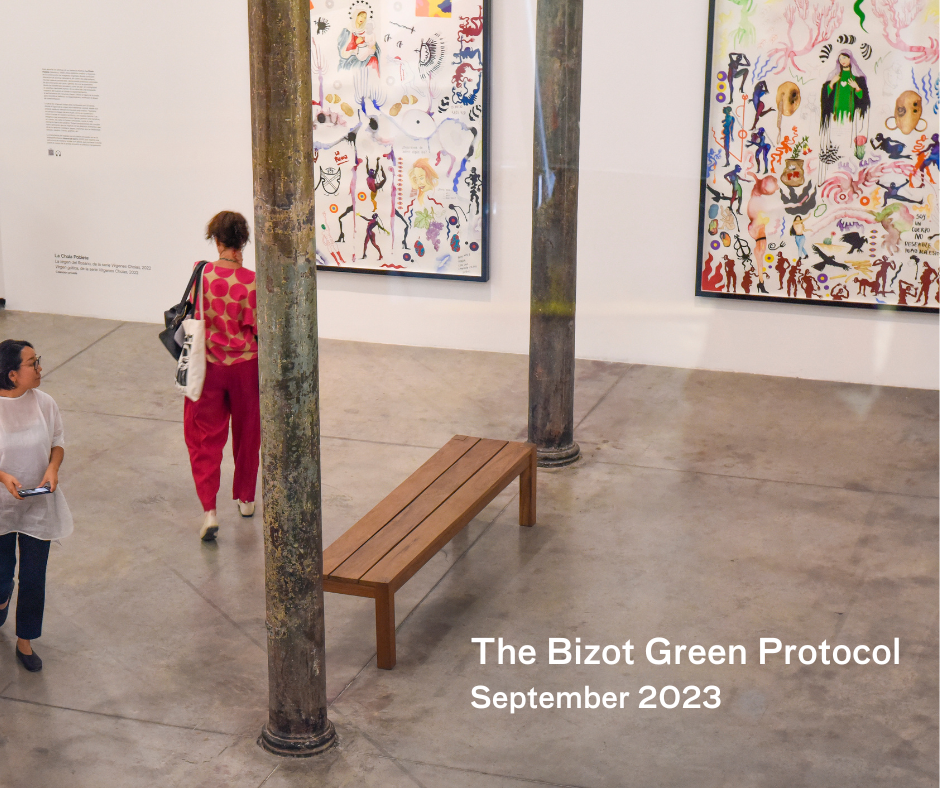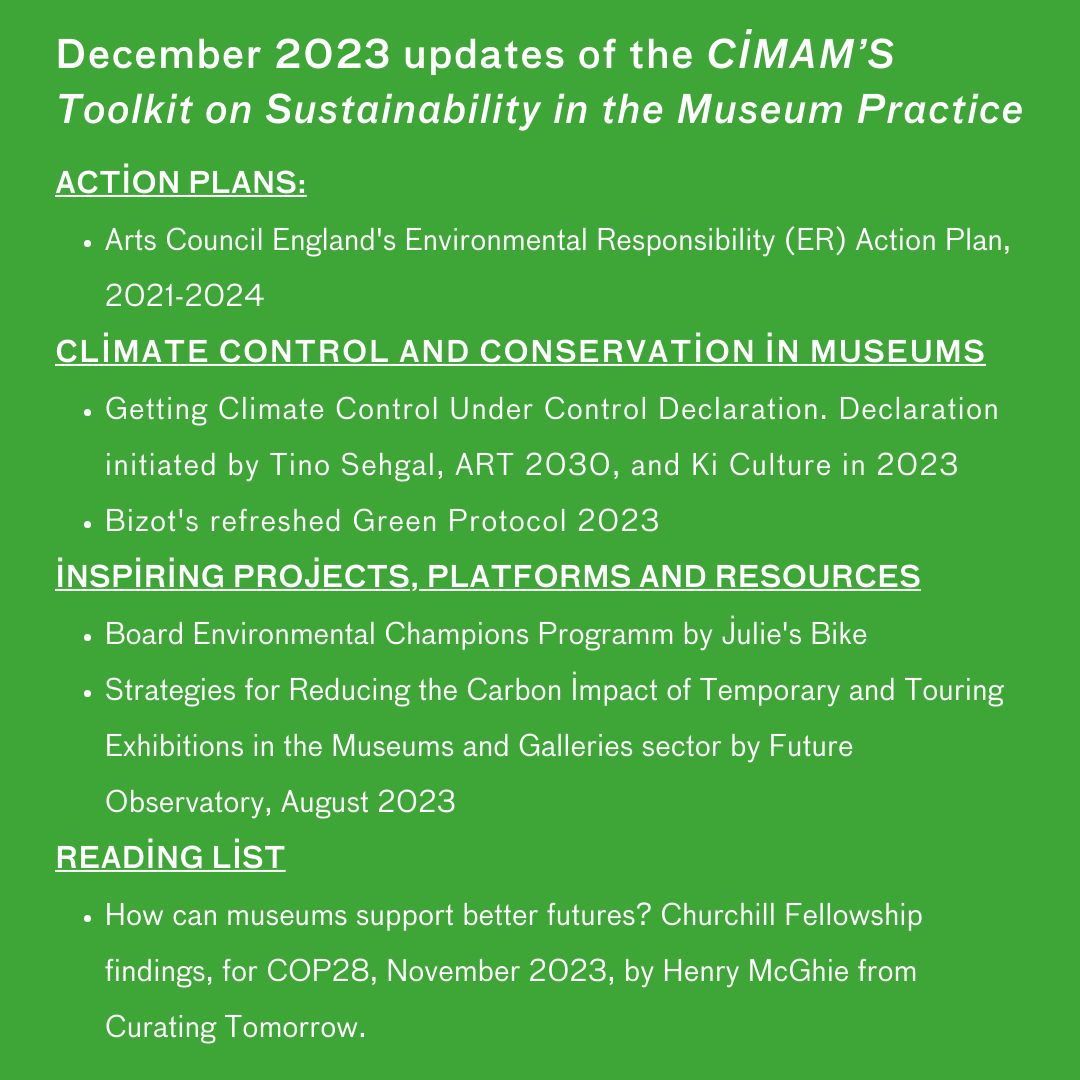Bizot's refreshed Green Protocol 2023

Since the publication of the Bizot Green Protocol in 2015, the climate crisis is increasingly recognized as one of the most important threats facing the world today. The cultural heritage sector must take urgent action to lead the fight against this problem.
At the same time, much research has been carried out to unravel the complexities of material behavior and environmental requirements. Current knowledge amply demonstrates that the adoption of broader environmental parameters does not compromise the safety of most collections.
Scientific evidence from experiments, observations, and field campaigns shows that museum collections survive exceptionally well under much wider climatic conditions than traditionally assumed. Practitioners can use user-friendly models and predictive tools developed for the cultural heritage sector to realistically assess the risk of damage posed by temperature and relative humidity for specific collections. These models can also help to identify particularly sensitive objects that can be separated from the general collection and treated with tailored solutions, without the need to apply narrow parameters for the whole collection.
While we argue that the risk posed to collections by variations in temperature and relative humidity within Bizot's parameters is minimal for most collections, it is also important to be clear that the figures 40-60% relative humidity and 16-25°C temperature with a daily variation of 10% have no fundamental scientific meaning. Rather, they represent figures that seemed reasonably acceptable ten years ago. We propose that they should be seen as a starting point for implementing sustainable environmental management strategies. In other words, we do not advocate replacing one prescriptive solution (50 ± 5% RH, 21±2°C) with another (40-60% RH, 16-25°C). On the contrary, we advocate a more nuanced determination of environmental parameters based on the conservation needs of the objects, as derived from scientific research and experience, and on the sustainability objectives of the institution.
To this end, it is essential that institutions adopt a risk management approach that replaces the traditional focus on avoiding at all costs minor risks that typically have a large financial and environmental impact. This transition will be easier if a multidisciplinary approach is also adopted, involving all relevant stakeholders such as engineers, architects, facilities managers, security staff, administrators, archivists, collection managers, curators, heritage scientists, conservators, and registrars.
In December 2022, the Bizot Group initiated an update and formed a working group of 54 museum professionals. They collaborated to align the protocol with evolving knowledge, technology, and the need for change.
The refreshed 2023 version of the Bizot Green Protocol is a science-based guiding principles, climate control guidelines, and a set of handbooks to accompany the protocol, offering scientific evidence, museum testimonials, and practical tools to facilitate its seamless adoption and implementation.
The updated protocol introduces new considerations such as transport and virtual couriering, which were successful during the COVID-19 pandemic.
It emphasise the urgent need for museums to adopt environmentally sustainable approaches to long-term collections care. These principles, which call for proactive and strategic engagement at all levels of the museum landscape, lay the groundwork for a holistic and high-impact transformation.
Delving into the intricacies of climate controls, the protocol deploys guidelines that push museums to adopt a "greener practices first mentality". In addressing the challenges related to carbon reduction, these guidelines highlight the importance of a systemic and collective effort, encouraging museums to prioritize sustainable practices as a core ethic.
A distinctive feature of the Bizot Green Protocol is its series of handbooks meticulously crafted to provide museums with tangible evidence, shared practices and practical tools. These handbooks serve as a repository of knowledge, drawing insights from the wealth of knowledge and experience in diverse museum fields, including contributions from climate science and international reports.
Handbook #1
ADOPTING THE BIZOT GREEN GUIDELINES
Last update: September 2023
This first handbook accompanies the ‘refresh Bizot Green Protocol’. It is intended to provide museum colleagues with evidence, tools and case studies to ease the adoption of the Bizot Green Guidelines and, more broadly, help museums to adopt climate control solutions that are safe for the objects and enable museums to reduce their energy consumption and carbon-emission.
Handbook #2
MOBILITY
Towards greener transport
Last update: May 2023
This second handbook accompanies the ‘refresh Bizot Green Protocol’. It is intended to provide museum colleagues with case studies and tools to help the adoption of more sustainable practices relating to the movement of objects in particular in the search for alternative to air freight wherever possible and the adoption of virtual courier as the default option.
To ensure its adaptability and relevance, the protocol commits to update every five years. This proactive approach stems from the protocol's dedication to keeping up with evolving knowledge, technological advances and the ever-changing landscape of museum practices.
Much more than a set of guidelines, the Bizot Green Protocol is a living document that evolves with the times. Recognizing challenges and championing collaboration, it positions itself as a catalyst for change. Navigating the complexities of the climate and natural crisis, the Bizot Green Protocol serves as a dynamic guide, orienting institutions towards a future in which sustainability is a fundamental ethic. In essence, it is not merely a protocol, but a visionary roadmap for museums to lead the way in fostering a sustainable cultural landscape.
Check the latest updates of December 2023 included in CIMAM's Toolkit on Sustainability in the Museum Practice.

Bizot Green Protocol, New York, November 13-15, 2014
Guiding Principles
Museums should review policy and practice, particularly regarding loan requirements, storage and display conditions, and building design and air conditioning systems, with a view to reducing carbon footprints. Museums need to find ways to reconcile the desirability of long-term preservation of collections with the need to reduce energy use.
Museums should apply whatever methodology or strategies best suit their collections, building and needs, and innovative approaches should be encouraged.
The care of objects is paramount. Subject to this,
- environmental standards should become more intelligent and better tailored to specific needs. Blanket conditions should no longer apply. Instead conditions should be determined by the requirements of individual objects or groups of objects and the climate in the part of the world in which the museum is located;
- where appropriate, care of collections should be achieved in a way that does not assume air conditioning or other high energy cost solutions. Passive methods, simple technology that is easy to maintain, and lower energy solutions should be considered;
- natural and sustainable environmental controls should be explored and exploited fully;
- when designing and constructing new buildings or renovating old ones, architects and engineers should be guided significantly to reduce the building’s carbon footprint as a key objective;
- the design and build of exhibitions should be managed to mimimise waste and recycle where possible.
Guidelines
For many classes of object containing hygroscopic material (such as canvas paintings, textiles, ethnographic objects or animal glue) a stable relative humidity (RH) is required in the range of 40 - 60% and a stable temperature in the range 16 - 25°C with fluctuations of no more than ±10% RH per 24 hours within this range. More sensitive objects will require specific and tighter RH control, depending on the materials, condition, and history of the work of art. A conservators evaluation is essential in establishing the appropriate environmental conditions for works of art requested for loan.